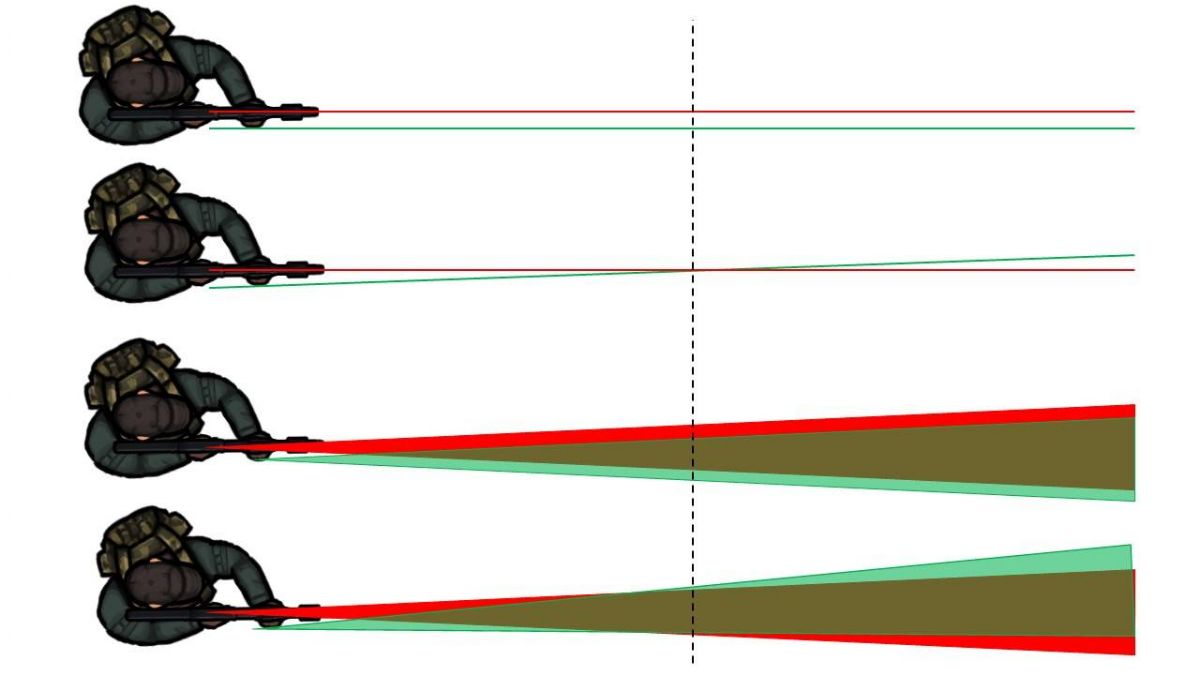::sigh::
I think it's probably coming time for a new IR laser zeroing video.
TL;DR: because of human error, beam divergence, and reticle size, 100+ yard coaligned zero and constant offset zero are probably identical. If you coalign laser and day sight at 100+ yards, at no point beyond that range will the offset be so great that the aim point of one sighting system doesn’t also cover the center of mass of your other aim point out to the reasonable identification and engagement range of a unity magnified NVG and effective range of your weapon system. Inside of 100 yards, your offset will never be greater than that of a parallel offset zero from your day sight. IR lasers are not precision targeting instruments.
All bets are off if you’re a sloppy zeroer.
So, some basic figures--I'm going to use the AN/PEQ-15 ATPIAL as the baseline for these figures since it's probably overall one of the most common IR lasers out there in terms of military, law enforcement, and commercial use. All this data is taken from the ATPIAL's operating manual:
The beam divergence (i.e., the angle of the "cone" of the IR laser over distance, basically the size of the dot) of the ATPIAL is 0.5mrad +/- 0.3mrad
The adjustments for the the ATPIAL are ~0.2mrad per click, or 2 clicks per box on a 25m zeroing target
The 25m offset for a top mounted ATPIAL on an M4 is 1.5 boxes (3 clicks) Left, and 0.5 boxes (1 click) Up
On the Telluric target, for a constant, parallel zero, the offset for (e.g.) a 200m BZO is 1.5 boxes (1 box = 1 cm = ~0.394 inches) Left, and ~ 2 boxes down, putting your constant offset at, oh, right around 0.590" laterally, and 0.787" vertically.
So, what does this all mean?
"Assuming" that the IR laser of the ATPIAL is roughly 2 MOA (spoiler alert, it's not, I'm being generous), a 0.5mrad beam divergence means that at 100m, the beam is roughly 2" in diameter, or (rounding) 51mm.
Thus, without going into the specific mathematics of it, if you perfectly zeroed the absolute center of both a 2 MOA RDS and 2 MOA laser with a perfect, parallel offset, by the time you hit 100 yards, they're both roughly 2" circles. Assuming they're constant offset, their center points are approximately 0.6" and 0.8" away from each other, i.e., well within the radius of the beam divergence/dot size, if you put the center of one dot on any particular aiming point, it will cover the center of the other dot, with no greater than a 0.8" margin of error in any direction with either dot at 100 yards, i.e., far beyond the capabilities of most ammunition, guns, or shooters to consistently hold, effectively
making them the same zero--anyone that thinks that they're going to use the "constant offset" to do precise holds with that kind of overlap versus margin of difference between the two aim points at that range is fooling themselves.
The reality is that chances are, whether you're doing a constant offset parallel zero or a converging/coaxial zero at an appreciable range (100 yds or more), you're probably ending up
with exactly the same zero within a margin of error of one or two clicks in any given direction, and given that those clicks equate to less than half of the beam divergence of the laser to begin with, it's a relatively moot point--again, an IR aiming laser, both in the way it's built and the way it's designed to be used, is not intended to be a precision aiming system, and as with any other sight, you will always have close-range offsets to learn, which again, are likely to be more or less identical.
People always act like we're talking about the top two, when really we're talking about the bottom two, and again, that only applies if 100% of your zeros are perfectly centered, however given margins of error, you're likely to be ending up with the same thing, or pretty close to, no matter how you do it, and again, where the "offset" at no point inside of 100 yards corresponds to more than 0.8" inches in any direction. (Obviously no part of the drawing is to scale, and the fact that the overlap is uneven in the bottom graphic has to do with the amount of fine rotation that PowerPoint will allow me--but it conveys the point).

~Augee
 Win a FREE Membership!
Win a FREE Membership!